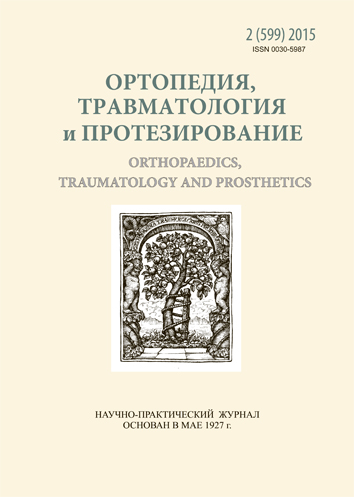Features of clinical and radiological characteristics of the area of consolidated fracture after osteosynthesis by means of biodegradable polymer polyglycolide implants in long terms
DOI:
https://doi.org/10.15674/0030-59872015230-34Keywords:
osteosynthesis, fracture, biodegradable polymers, polyglycolide, long-term resultsAbstract
Objective: To determine clinical and radiological changes, peculiarities of CT and MRI images of the area of consolidated fracture after osteosynthesis by means of biodegradable polymer of polyglycolide implants in long terms. Methods: Outcomes of treatment in 37 patients within 6–30 years with using of clinical and instrumental (radiography, MRI, CT) methods. Results: In patients in 30 years after surgeries there were no pain or other discomfort felings, acute inflammation in the area of polyglycolide implantation. Limb function and overall condition of patients were satisfactory. Radiologically in long terms there was defined formation of a distinct trabecular bone structure in the area of implementation of polyglycolic fixateur. During MRI examination distinct bone structure without any pathological formations was detected. Manifestations of local swelling and inflammation in the area of implantation, as well as thickening of the joint capsule, excess fluid, signs of inflammation in the joint and surrounding tissues have been not identified. Age-related degenerative changes were similar on contralateral and operated limb. During CT it was determined that the density and structure of bone tissue at the implantation site of the polyglycolide fixateur was not significantly different from that one in the contralateral limb. Conclusions: It was found that within 30 years after implantation of fixateurs made of polyglycolide processes of bone tissue regeneration are not violated, and pathological formations in bone and soft tissues are not formed. Polyglycolide and products of its biodegradation do not lead to the development or enhancement of degenerative processes in joints of the operated limb for a long period of observation. The results of applying of investigated fixateurs are not inferior to foreign analogues «Biofix», «Lactosorb», «Activascrew».References
- Kontakis G. M. Bioabsorbable materials in orthopaedics / G. M. Kontakis, J. E. Pagkalos, T. I. Tosounidis [et al.] // Acta Orthop. Belg. — 2007. — Vol. 73 (2). — P. 159–169.
- Bioresorbable polymers in orthopedics and traumatology /V. A. Radchenko, N. V. Deduh, S. V. Malyishkina, L. M. Bengus// Orthopaedics, Traumatology and Prosthetics. — 2006. — № 3. — P. 116–124.
- Dudko G. E. Medico-social and economical aspects of the surgical treatment of fractures by polymer and metal-polymer constructions / G. E. Dudko, I. M. Rublenik // Soviet Medicine. — 1991. — № 12. — P. 43–45.
- Dudko O. G. Late outcome and medico-social aspects of the surgical treatment fractures of extremities with polymeric fixing devices: dissertation abstract. …. PhD degree: 14.01.21 / Oleksii Gennadiyovich Dudko. — Kiev, 2012. — 24 p.
- Chyoniy V. N. Perspectives of application magnesium biodegradable alloys for internal fracture fixation (a review) /V. N. Chyorniy // Zaporozhye Medical Journal — 2013. — № 6. — P. 76–79.
- Bhardwaj R. Advances in the properties of polylactides based materials: a review / R. Bhardwaj, K. A. Mohanty // J. Biobased Materials and Bioenergy. — 2007. — Vol. 1 (2). — P. 191–209.
Downloads
How to Cite
Issue
Section
License
Copyright (c) 2015 Olexiy Dudko

This work is licensed under a Creative Commons Attribution 4.0 International License.
The authors retain the right of authorship of their manuscript and pass the journal the right of the first publication of this article, which automatically become available from the date of publication under the terms of Creative Commons Attribution License, which allows others to freely distribute the published manuscript with mandatory linking to authors of the original research and the first publication of this one in this journal.
Authors have the right to enter into a separate supplemental agreement on the additional non-exclusive distribution of manuscript in the form in which it was published by the journal (i.e. to put work in electronic storage of an institution or publish as a part of the book) while maintaining the reference to the first publication of the manuscript in this journal.
The editorial policy of the journal allows authors and encourages manuscript accommodation online (i.e. in storage of an institution or on the personal websites) as before submission of the manuscript to the editorial office, and during its editorial processing because it contributes to productive scientific discussion and positively affects the efficiency and dynamics of the published manuscript citation (see The Effect of Open Access).














